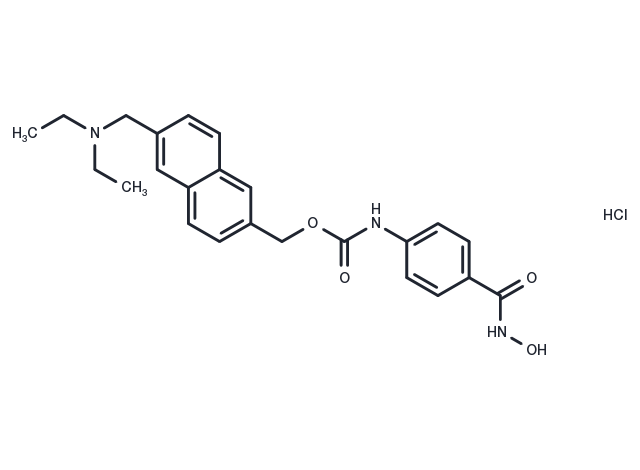Powder: -20°C for 3 years | In solvent: -80°C for 1 year


Givinostat hydrochloride (ITF2357 hydrochloride) is an inhibitor of HDAC with IC50 of 198 and 157 nM for HDAC1 and HDAC3, respectively. Givinostat hydrochloride exhibits anti-inflammatory, anti-angiogenic, and antineoplastic activities.

| Pack Size | Availability | Price/USD | Quantity |
|---|---|---|---|
| 1 mg | In stock | $ 67.00 | |
| 2 mg | In stock | $ 95.00 | |
| 5 mg | In stock | $ 136.00 | |
| 10 mg | In stock | $ 227.00 | |
| 25 mg | In stock | $ 477.00 | |
| 50 mg | In stock | $ 698.00 | |
| 100 mg | In stock | $ 993.00 | |
| 500 mg | In stock | $ 1,990.00 | |
| 1 mL * 10 mM (in DMSO) | In stock | $ 219.00 |

| Description | Givinostat hydrochloride (ITF2357 hydrochloride) is an inhibitor of HDAC with IC50 of 198 and 157 nM for HDAC1 and HDAC3, respectively. Givinostat hydrochloride exhibits anti-inflammatory, anti-angiogenic, and antineoplastic activities. |
| Targets&IC50 | HD1-B:7.5 nM (IC50), HDAC10 (human):340 nM (IC50), HDAC6 (human):315 nM (IC50), HDAC3 (human):157 nM (IC50), HD2:10 nM (IC50), HDAC9 (human):541 nM (IC50), HDAC4 (human):1059 nM (IC50), HD1-A:16 nM (IC50), HDAC11 (human):292 nM (IC50), HDAC7 (human):524 nM (IC50), HDAC2 (human):325 nM (IC50), HDAC8 (human):854 nM (IC50), HDAC1 (human):198 nM (IC50), HDAC5 (human):532 nM (IC50) |
| In vitro | Givinostat hydrochloride inhibits JS-1 cell proliferation in a concentration-dependent manner. Givinostat hydrochloride (≥500 nM) is associated with significant inhibition of JS-1 cell proliferation. Also, the cell inhibition rate significantly differs between the group cotreated with Givinostat hydrochloride ≥250 nM plus LPS and the group without LPS treatment[3]. Givinostat hydrochloride (25, 50, and 100 nM) reduces IL-1β secretion more than 70%. Givinostat hydrochloride suppresses the production of IL-6 in PBMCs stimulated with TLR agonists as well as the combination of IL-12 plus IL-18. IL-6 secretion decreases to 50% at 50 nM, but at 100 and 200 nM, there is no reduction[4]. |
| In vivo | Givinostat hydrochloride (10 mg/kg) reduces serum TNFα by 60%. Pretreatment of Givinostat hydrochloride (0.1 mg/kg) significantly reduces the circulating TNFα by nearly 90%[4]. |
| Synonyms | ITF2357 hydrochloride, Givinostat HCl, ITF2357, ITF 2357, ITF-2357, ITF2357 HCl |
| Molecular Weight | 457.95 |
| Formula | C24H28ClN3O4 |
| CAS No. | 199657-29-9 |
Powder: -20°C for 3 years | In solvent: -80°C for 1 year
DMSO: 27.5 mg/mL (60.05 mM)
You can also refer to dose conversion for different animals. More
bottom
Please see Inhibitor Handling Instructions for more frequently ask questions. Topics include: how to prepare stock solutions, how to store products, and cautions on cell-based assays & animal experiments, etc.
Givinostat hydrochloride 199657-29-9 Chromatin/Epigenetic DNA Damage/DNA Repair HDAC ITF2357 hydrochloride inhibit Givinostat HCl Givinostat Hydrochloride ITF-2357 Hydrochloride Histone deacetylases ITF2357 ITF 2357 Hydrochloride Givinostat ITF 2357 ITF-2357 Inhibitor ITF2357 Hydrochloride ITF2357 HCl inhibitor
